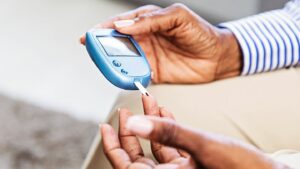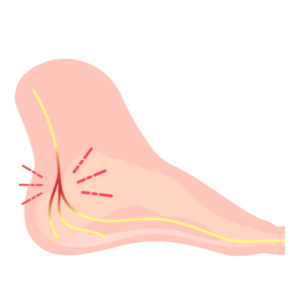Diabetic polyneuropathy is a common complication of diabetes mellitus, affecting a significant number of individuals worldwide. This condition involves nerve damage due to prolonged exposure to high levels of blood sugar. As the prevalence of diabetes continues to rise, it becomes crucial to delve into effective treatments for diabetic polyneuropathy. In this blog post, we will explore the causes, symptoms, and various diabetic polyneuropathy treatment options available for managing this complex condition.
Contents
Understanding Diabetic Polyneuropathy

Diabetic polyneuropathy is a type of peripheral neuropathy that affects multiple nerves throughout the body. It usually develops over time as a result of prolonged exposure to elevated blood sugar levels. The condition is characterized by nerve damage that can lead to symptoms such as tingling, numbness, pain, and weakness, particularly in the extremities.
Causes:
The exact mechanisms behind diabetic polyneuropathy are not fully understood, but several factors contribute to its development:
- Hyperglycemia: Prolonged periods of high blood sugar levels can damage the blood vessels that supply oxygen and nutrients to the nerves.
- Metabolic factors: Abnormalities in lipid metabolism and insulin resistance may contribute to nerve damage.
- Autoimmune factors: Inflammation triggered by an autoimmune response might play a role in the development of diabetic polyneuropathy.
Symptoms:
The symptoms of diabetic polyneuropathy can vary from mild to severe and may include:
- Tingling or burning sensations
- Numbness
- Sharp, stabbing pain
- Muscle weakness
- Difficulty walking
- Sensitivity to touch
- Loss of balance and coordination
Treatment Options for Diabetic Polyneuropathy
While there is no cure for diabetic polyneuropathy, various treatment options aim to manage symptoms, slow the progression of the condition, and improve overall quality of life. A comprehensive treatment approach may include:
Blood Sugar Control

Blood sugar control is the cornerstone of managing diabetic polyneuropathy. Prolonged exposure to high levels of glucose in the bloodstream is a major contributing factor to nerve damage. To effectively control blood sugar, individuals with diabetes need to adopt a multifaceted approach.
- Medication: For many, oral medications like metformin, sulfonylureas, or insulin injections are prescribed to regulate blood sugar levels.
- Dietary Modifications: Adopting a well-balanced, low-glycemic diet is vital in managing blood sugar levels.
- Lifestyle Adjustments: Regular physical activity plays a pivotal role in blood sugar control.
Medications
Medications are often prescribed to manage the symptoms associated with diabetic polyneuropathy, particularly pain and discomfort. Two classes of medications commonly used are pain relievers and antidepressants.
Pain Relievers: Over-the-counter pain medications like acetaminophen or nonsteroidal anti-inflammatory drugs (NSAIDs) may provide relief for mild pain. However, for neuropathic pain, prescription drugs such as pregabalin and gabapentin are frequently recommended. These drugs act on the central nervous system, modulating pain signals and providing relief from tingling, burning, or shooting pain.
Antidepressants: Certain antidepressant medications, such as amitriptyline or duloxetine, are effective in managing neuropathic pain. These medications work by altering the perception of pain signals in the brain and can also improve sleep patterns, which are often disrupted in individuals with diabetic polyneuropathy.
Physical Therapy

Physical therapy is an integral component of managing diabetic polyneuropathy, focusing on improving mobility, strength, and coordination.
Exercise Regimens: Physical therapists design exercise regimens tailored to an individual’s specific needs and limitations. These exercises may include stretching, balance training, and strength-building activities. Engaging in regular physical activity not only helps maintain muscle function but also improves blood circulation, contributing to overall nerve health.
Gait and Balance Training: For those experiencing difficulties with walking and balance, physical therapists employ gait and balance training techniques. These exercises enhance coordination and reduce the risk of falls, which can be particularly concerning for individuals with diabetic polyneuropathy.
Lifestyle Modifications
Adopting a healthy lifestyle is essential for managing diabetic polyneuropathy and preventing further complications associated with diabetes.
Regular Exercise: Physical activity is not only crucial for blood sugar control but also for overall well-being. Regular exercise improves cardiovascular health, enhances insulin sensitivity, and contributes to weight management. Activities such as walking, swimming, or cycling are recommended, with intensity and duration adjusted based on individual fitness levels.
Balanced Diet: A well-balanced diet is fundamental in managing diabetes and its complications. Emphasis should be placed on consuming a variety of nutrient-dense foods, including fruits, vegetables, whole grains, lean proteins, and healthy fats. Monitoring carbohydrate intake and spacing meals throughout the day can help regulate blood sugar levels.
Weight Management: Maintaining a healthy weight is essential in managing diabetes and reducing the burden on the body. Weight loss, if necessary, is typically achieved through a combination of a balanced diet and regular exercise.
Peripheral Neuropathy Treatments
Various treatments specifically target the symptoms of peripheral neuropathy associated with diabetic polyneuropathy.
Transcutaneous Electrical Nerve Stimulation (TENS): TENS is a non-invasive therapy that involves the use of low-voltage electrical currents to alleviate pain. Small electrodes are placed on the skin, delivering electrical impulses that disrupt pain signals and provide relief. TENS is considered a safe and effective adjunctive therapy for managing neuropathic pain.
Laser Therapy: Low-level laser therapy (LLLT) has shown promise in reducing pain and improving nerve function in individuals with diabetic polyneuropathy. Laser therapy stimulates cellular activity and enhances blood flow, promoting nerve repair and regeneration.
Alternative Therapies
Complementary and alternative therapies are often explored to enhance the overall management of diabetic polyneuropathy.
Acupuncture: Acupuncture involves the insertion of thin needles into specific points of the body to stimulate energy flow. Some individuals find relief from neuropathic pain through acupuncture, although the mechanisms behind its effectiveness are not fully understood.
Biofeedback: Biofeedback is a technique that helps individuals gain control over physiological processes, such as heart rate and muscle tension, to improve overall well-being. While research on biofeedback for diabetic polyneuropathy is limited, some individuals report reduced pain and improved quality of life with this approach.
Wound Care and Foot Protection
Individuals with diabetic polyneuropathy are at an increased risk of foot complications. Proper foot care, including regular inspections, moisturizing, and using appropriate footwear, is crucial. Additionally, foot protection strategies such as wearing comfortable shoes and avoiding activities that may lead to injuries should be emphasized.
Neuropathic Ulcer Management
For those with advanced diabetic polyneuropathy, the development of neuropathic ulcers on the feet is a concern. Specialized wound care, including debridement and infection control, is essential. Working closely with healthcare professionals, including wound care specialists and podiatrists, can help prevent complications and promote healing.
Vitamin and Mineral Supplementation
Some individuals with diabetic polyneuropathy may benefit from vitamin and mineral supplements. For example, vitamin B complex supplements, including B1 (thiamine), B6 (pyridoxine), and B12 (cobalamin), are often recommended as they play a role in nerve health. However, it’s crucial to consult with healthcare professionals before initiating any supplementation, as excessive doses can have adverse effects.
Topical Treatments
Topical treatments, such as creams or patches containing medications like capsaicin (derived from chili peppers), may provide localized relief for neuropathic pain. Before using topical treatments, discuss them with your healthcare provider to ensure they are safe and suitable for your specific condition.
Invasive Procedures
In some cases, when conservative treatments prove ineffective, invasive procedures may be considered. Nerve blocks or spinal cord stimulation are examples of interventions that aim to alleviate pain by directly targeting affected nerves. These procedures carry risks and benefits and should only be pursued after careful consideration and consultation with specialists.
Considerations To Keep In Mind While Getting Diabetic Polyneuropathy Treatment

Navigating the treatment landscape for diabetic polyneuropathy requires careful consideration of various factors. Here are important considerations to keep in mind while seeking and undergoing treatment for diabetic polyneuropathy:
- Consultation with Healthcare Professionals: Before embarking on any treatment plan, it is crucial to consult with healthcare professionals specializing in diabetes and neuropathy. This may include endocrinologists, neurologists, and physical therapists. These specialists can provide a comprehensive evaluation of your condition and guide you toward the most effective and personalized treatment strategies.
- Individualized Treatment Plans: Diabetic polyneuropathy manifests differently in each individual. Treatment plans should be tailored to address the specific symptoms, severity, and underlying factors affecting each person. One size does not fit all, and a personalized approach is key to optimizing outcomes.
- Regular Follow-Up Appointments: Diabetic polyneuropathy is a chronic condition that requires ongoing management. Regular follow-up appointments with healthcare professionals allow for the monitoring of symptoms, adjustments to treatment plans, and early intervention in case of any complications. These appointments are also an opportunity to address any questions or concerns you may have.
- Patient Education: Understanding the nature of diabetic polyneuropathy, its progression, and the rationale behind recommended treatments is empowering. Patient education is key to fostering active participation in one’s healthcare. Stay informed about your condition, treatment options, and lifestyle modifications that can positively impact your well-being.
- Potential Side Effects and Risks: Be aware of potential side effects associated with medications or treatments prescribed for diabetic polyneuropathy. Discuss these potential side effects with your healthcare provider, and promptly report any unexpected or severe reactions. An informed and vigilant approach ensures timely adjustments to the treatment plan if needed.
- Mental Health Considerations: Living with a chronic condition can take a toll on mental health. Stress, anxiety, and depression can exacerbate symptoms and impact overall well-being.
Conclusion
Diabetic polyneuropathy is a challenging complication of diabetes, but with proper management and a multidisciplinary approach, individuals can lead fulfilling lives. Individuals with diabetes must work closely with healthcare professionals to create a personalized treatment plan that addresses their specific needs. Through a combination of blood sugar control, medication, physical therapy, and lifestyle modifications, the impact of diabetic polyneuropathy can be minimized, and the progression of the condition can be slowed down, ultimately improving the overall quality of life for those affected.
Do you want to get rid of diabetes? Join our online diabetes treatment program and reverse Diabetes naturally through lifestyle changes such as a Personalized Diet plan, Exercise, Yoga, dieticians, and health coaches.

